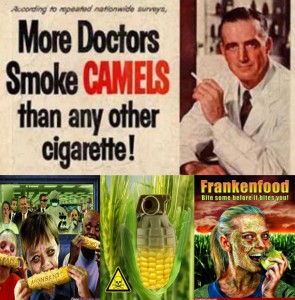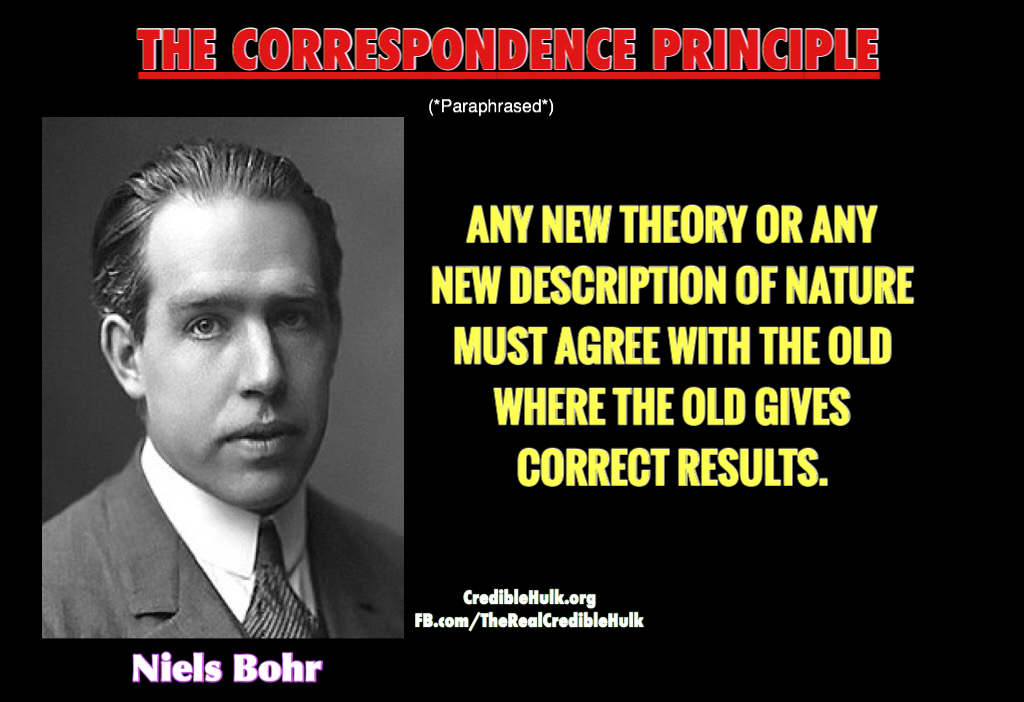Bringing up pictures of doctors smoking cigarettes is a common tactic used by anti-GMO activists and other critics of “mainstream” science to cast doubt and mistrust on matters of scientific consensus by implying that a world wide scientific consensus can realistically be bought off by corporations, and insinuating that that is, in fact, what is actually happening.
The claim comes up frequently enough that I think it deserves to be directly addressed, so let’s put this tired canard to bed for all time.
One of the fatal problems with this argument, of which there are many, is that the scientific consensus never was in favor of cigarette safety to begin with. In fact, it was known as far back as the 1930s that epidemiological data suggested a connection between smoking and lung cancer, and other detrimental health effects were documented as far back as 250 years ago.
People using this comparison between tobacco companies and the consensus of legitimate science are attempting to equate the content of paid advertising campaigns with the views of the broader scientific community, which is naive at best, and dishonest at worst.
Looking back, the thinly veiled obfuscation attempts by the tobacco companies seem conspicuous now because the dangers of smoking had already been established (and were continuing to be further established) by independent research, while the tobacco sponsored researchers were simultaneously attempting to formulate alternative explanations for the increased cancer risk and other health problems correlated with smoking. The tobacco companies never controlled the science of the matter and never really had scientific consensus on their side. What they had was a good PR department and enough cash to bankroll a few scientists and doctors into speaking positively about smoking tobacco despite the weight of the evidence against them. These phenomena are elucidated here , here and here. The same companies later exhibited similar patterns of behavior for many years with respect to the controversy surrounding the health effects of second hand smoke.
On the other hand, the safety of genetically engineered foods does have a strong scientific consensus behind it, and there aren’t really any credible studies from any source showing any damage to animals or people attributable to any of the currently used transgenic crops. There is simply no evidence of an attempted cover-up, and there are no papers postulating alternative explanations for negative results, simply because no such results have been found that would require explanation. Moreover, there is no systematic contradiction between independent studies versus industry-funded ones either, which we should expect to see if “Big Biotech” was really manipulating the data and buying off all of the world’s biotech scientists.
Instead, the only evidence we find of deliberate spin and misleading data is in papers by Seralini, Seneff and Carman, which have been found to be lacking in solid, credible scientific rigor, and by frequently repeated claims by anti-GMO front organizations and their supporters. Although most of the media attention tends to focus on “Big Biotech,” organic food is an $63 billion dollar industry, much larger than any of the big biotech companies, and many of them have been engaged in vehement ongoing smear campaigns opposing transgenic crops, yet their allies consistently publicly criticize biotech companies for fighting unjustified labeling mandates and accuse them of buying off scientists and scientific journals (despite having precisely zero evidence to corroborate their accusations).
Ironically, Just-Label-It and Mamavation, two of the most well known anti-GMO groups, have been openly advertising to pay bloggers to argue for their cause, thus demonstrating that their hypocritical use of the shill gambit against pro-science people has been nothing more than a case of psychological projection (as Kavin Senapathy discusses here). The infamous Mike Adams, the founder of anti-science website Natural News, even went as far as to assemble a “kill list” of known scientists and science advocates he characterized as “Monsanto Collaborators.” To the best of my knowledge, not even the tobacco companies have stooped as low as to call for the execution of people known for debunking their claims.
So, the reality is that there is no analogy between GMOs and tobacco.
There is evidence of detrimental Heath effects from smoking being known to science 200 years before the tobacco company fiasco that tragically duped so many laypeople.
The safety of cigarettes was never the prevailing scientific consensus, and people looking for justifications to ignore or deny science now will just have to come up with a better excuse than this.
QED
BOOM!
UPDATE:
Shortly after the original publication of this piece, Marc Brazeau, founder of Food and Farm Discussion Lab, wrote the following response piece. In the piece, Marc takes issue with a line towards the end of this piece in which I said:
“So, the reality is that there is no analogy between GMOs and tobacco.”
He agreed with everything else in the original version of this piece except for that concluding line, and I think it’s worth looking at his argument, because upon examining it, I think that he’s right. Marc argues as follows:
“I would actually argue that there is a strong analogy between GMOs and Tobacco Science. What obscures the analogy is that the roles are reversed in ways that obscure the parallels. With “tobacco science” we had big business twisting, cherry-picking and manipulating the science in an attempt to confuse the public and provide cover for policy makers they have in their pocket. What we see today with GMOs is similar twisting, cherry-picking and manipulating of the science relating to biotech crops in order to confuse the public and drive policy-making.
Except that instead of Big Ag, the source of misinformation and misconceptions is environmental and public interest watchdog groups. For those of us used to turning to these groups to make sense of scientific research and let us know the policy implications, this can be disorienting to say the least. If you are an environmentalist or any sort of liberal/lefty it can really throw you off your bearings to realize that they guys you thought were wearing the white hats are the ones blowing smoke, muddying the waters, and sowing confusion.”
For examples, see here, here, here, and here.
Marc makes valid points, and I concede his (much stronger) conclusion: Anti-GMO groups are the ones guilty of utilizing the tactics of tobacco companies.





34 Comments
Eric Bjerregaard · May 17, 2015 at 5:32 pm
Thanks, very thorough and easy to understand. I will save and post in arguments and the activists will not rad it. Over and over again. But some thinking folks just might read.
Credible Hulk · May 17, 2015 at 6:03 pm
I’m glad you liked it, Eric. I hope that it ends up coming in handy.
Kris · April 18, 2016 at 4:46 am
Hey, that’s the grttseae! So with ll this brain power AWHFY?
cartier bracelets prices · June 3, 2015 at 3:16 pm
It’s a joy to find someone who can think like that
cartier bangle replica · June 3, 2015 at 4:50 pm
Не нужно волноваться за Россию. В России всё нормально. Лучше ищите ветки и собирайте мусор чтобы было чем топить, а то замёзните в мечтах о богатой жизни.
fake cartier bracelets · June 3, 2015 at 8:46 pm
Try reading the second to last paragraph of Alex’ introduction above.
Alena · June 8, 2015 at 1:10 pm
I am really enjoying the theme/design of your web site. Do you ever run into any web browser compatibility problems? A couple of my blog visitors have complained about my site not operating correctly in Explorer but looks great in Opera. Do you have any advice to help fix this problem?
Credible Hulk · June 8, 2015 at 9:44 pm
I’ve only had this site for a few weeks as of this writing, but for whatever it’s worth, I haven’t run into problems like that yet myself.
sdorttuii plmnr · June 10, 2015 at 8:34 am
Thank you, I have recently been looking for info approximately this topic for a while and yours is the best I have came upon so far. But, what in regards to the bottom line? Are you sure about the source?
Jamie · June 11, 2015 at 5:39 am
There is noticeably a bundle to know about this. I assume you made certain good points in options also.
skin healthy · June 12, 2015 at 1:59 am
My brother recommended Ӏ miɡht like this blog.
Ηе was entіrely right. Thiѕ post actually made my ɗay.
You cann’t imagine simply how mսch time I had spent for tҺis information! Thɑnks!
Have а lօօk at mƴ website: skin healthy
removal boxes · June 15, 2015 at 7:41 pm
A fascinating discussion is worth comment. I think that you ought to write
more about this subject, it might not be a taboo subject but generally people do not talk about these topics.
To the next! Kind regards!!
Plasticizer · June 15, 2015 at 8:32 pm
The company main business is further process the petrochemical production, with 8 production lines of ten-thousand-ton capacity for C9 and C10 separators, thermal & cold polymerization petroleum resin, petroleum naphthalene, tar and thousand-ton capacit
Arden · June 18, 2015 at 8:40 am
You are a very bright individual!
Cinthia · June 22, 2015 at 6:17 pm
Hey! I could have sworn I’ve been to this blog before but after browsing through some of the post I realized it’s new to me. Nonetheless, I’m definitely happy I found it and I’ll be bookmarking and checking back frequently!
additional info · June 25, 2015 at 2:53 pm
I simply want to say I am just newbie to blogs and certainly loved your web site. Almost certainly I’m going to bookmark your website . You really have tremendous posts. Many thanks for revealing your website page.
backlinks service · June 30, 2015 at 7:02 pm
vc3eCV Appreciate you sharing, great post.Thanks Again. Awesome.
sdorttuii plmnr · July 1, 2015 at 4:59 pm
It’s arduous to find educated folks on this matter, but you sound like you understand what you’re talking about! Thanks
ÿþS · July 9, 2015 at 4:22 pm
Valuable information. Lucky me I found your website by accident, and I am shocked why this accident did not happened earlier! I bookmarked it.
teaching a child to read · July 10, 2015 at 2:58 pm
Just desire to say your article is as amazing. The clarity in your post is simply nice and i could assume you are an expert on this subject. Fine with your permission let me to grab your feed to keep updated with forthcoming post. Thanks a million and please continue the enjoyable work.
Lisa · April 17, 2016 at 11:28 pm
That’s a nicely made answer to a chnalengilg question
MiltonXNighbor · July 21, 2015 at 4:52 pm
I enjoy reading through an article that can make men and
women think. Also, many thanks for permitting me to comment!
perfect age · July 22, 2015 at 7:16 pm
Hi i am kavin, its my first time to commenting anyplace,
when i read this article i thought i could also make comment due to this brilliant post.
BerryEMustafaa · July 23, 2015 at 4:01 pm
Excellent article! We will be linking to this great content
on our website. Keep up the good writing.
jenny · September 14, 2015 at 6:37 pm
the issue isn’t if GMOs are safe or not- it’s the pesticides dumped on GMO vs non-GMO. that is indeed proven. If it is not, I ask you to put a half drop of RoundUp in your daily coffee and check back in with us next year.
Credible Hulk · September 26, 2015 at 4:18 am
Hi Jenny. In afraid that you’ve been misinformed. Firstly, GMOs have actually helped reduce pesticide use: not increase it (contrary to anti-GMO and organic industry mythology).
According to the latest Brookes and Barfoot paper, biotech crops have decreased pesticide use. More specifically, it shows an 8.6% decrease in pesticide use (by mass). They’ve also helped cut greenhouse gas emissions due to farming by the equivalent of removing 12.4 million cars from the road, and reduced the Environmental Impact Quotient (EIQ) by 19.1%.
Abstract
>This paper updates previous assessments of how crop biotechnology has changed the environmental impact of global agriculture. It focuses on the environmental impacts associated with changes in pesticide use and greenhouse gas emissions arising from the use of GM crops since their first widespread commercial use in the mid 1990s. The adoption of GM insect resistant and herbicide tolerant technology has reduced pesticide spraying by 553 million kg (-8.6%) and, as a result, decreased the environmental impact associated with herbicide and insecticide use on these crops (as measured by the indicator the Environmental Impact Quotient (EIQ)) by 19.1%. The technology has also facilitated important cuts in fuel use and tillage changes, resulting in a significant reduction in the release of greenhouse gas emissions from the GM cropping area. In 2013, this was equivalent to removing 12.4 million cars from the roads.< Moreover, although the rise in popularity of glyphosate-resistant (GR) crops in particular has coincided with an increase in the use of glyphosate, what critics invariably fail to mention is that its rise in popularity also coincided with the phasing out of other herbicides, most of which were significantly more toxic than glyphosate.
Thirdly, now days every pesticide (whether man made or otherwise) has to undergo extensive testing on toxicity: (acute, chronic and subchronic), the former of which involves (among other things) the discovery of its LD50, the dose per unit mass at which half of the subjects will die of acute overdose, and the latter of which involves extensive multi-animal testing to find reference doses (RfD) using an experimentally derived quantity known as the toxological end point, or the No Observable Adverse Effect Limit (NOAEL), from which the EPA computes what they call “tolerances,” which are typically at least an order of magnitude or two lower than the lowest dose ever observed to have any observable effect in the most sensitive animals (that extra cushion is to account for variability in sensitivity across the population). If trace residues are found to exceed these tolerances, the food cannot be sold.
It is also common to assess for carcinogenic potential, mutagenic and potential effects on fetal development.
I’ve written about this in greater detail for the case of glyphosate here:
My experience is that most people are not taught about these standards and how they are accomplished, and thus it’s easy for them to imagine worse case scenarios because they don’t realize how tightly regulated things are now days. So, far from being ” proven harmful,” when used as directed and in amounts under the required EPA standards, the pesticides associated with GM seeds are actually quite safe. The same is true of most non-GMO and organic approved pesticides.
It’s funny that you used the example of putting a drop of RoundUp in your coffee considering the fact that the caffeine is actually more toxic in a milligram to milligram that glyphosate (the active ingredient in glyphosate). If anything, the surfactants would likely give you gastrointestinal problems long before you could drink enough to experience an acute toxic effect from the glyphosate. More importantly, drinking straight RoundUp would be an example of not using the product as directed, and would bear no relevance whatsoever to its safety when used as directed.
That said, it didn’t stop this guy from drinking straight RoundUp as a stunt, and he’s perfectly fine (though I wouldn’t recommend copying him, because it’d be pointless to do so regardless of the outcome.
Anyway, thanks for dropping by my blog, and I hope that helps clear up some misconceptions for you. 🙂
Bronson Kaahui · October 3, 2015 at 9:21 am
I did a video on this a while ago, the anti-GMO movement is more like Big Tobacco than the scientific community. They are the ones trying to discredit the science and pretend like there is greater uncertainty than there is.
https://www.youtube.com/watch?v=fuPX8uPXvXo
Credible Hulk · October 9, 2015 at 10:05 pm
Very nice. I’ve actually seen this before. I think you shared it on GMOLOL a few months back, yes? Anyway, good video.
gestapo · November 13, 2015 at 7:04 pm
How do I go about copyrighting content of my website?
Larry Morgan · July 2, 2016 at 5:20 am
Well Cedible Hulk, I appreciate that tobacco is an imperfect comparison but I appreciate that both you and Eric seem to agree that scientific consensus can be bought which really was that my opening point. I was just unaware of that the big money was in anti GMO. Seems reasonable. LOL Here are my thoughts and concerns (spoiler alert: there will be no mic drop at the end. LOL)
My point for opposition would be primarily that science should be careful particularly in this field. One of the first things that come to mind is the correlation between the increase in non-celiac gluten sensitivity and the rise of what is called “modern wheat” which has increased gluten proteins and decreased mineral content due to hybridization intended to increase wheat crops. I first came into my thought process when I heard of cardiologist, William Davis’ book Wheat Belly. I believed Gluten intolerance was silly hippy stuff but there is plenty of anecdotal evidence and it has been evidenced by a recent double blind study in the MDPI journal. Additionally, modern wheat has been so modified by humans that the modern strains of wheat are unable to grow in the wild this seems like we could be potentially moving in the wrong direction there and brings me to my second point, bananas.
Some people here may be old enough to remember that bananas used to taste completely different. This is the taste we know as the artificial banana flavor. It was the flavor of the big mike bananas where cultivated (artificially propagated, creating new plants from a variety of sources) by man. The cultivation process caused the big mikes to be particularly vulnerable to a fungal pathogen which wiped out almost all the bananas in the 1950s. The bananas cultivated today are a lesser quality and are now themselves in danger of being wiped out.
These are two examples of unintentional consequences caused by industrializing food production for profits.
Lastly, I would ask that you keep in mind the fact that, fan-favorite, skeptic Bill Nye was a longtime opponent of GMOs. He did change his mind (and I may too, eventually) but, his opposition wasn’t based on new-ageism. His opinion was based on what he believed to be sound science. So unless you think he went from an idiot to a genius, you should be able to admit there is enough evidence that a person of sound and scientific mind COULD believe GMOs are dangerous.
Credible Hulk · January 9, 2018 at 2:21 am
I don’t know where you thought anyone was conceding that a scientific consensus can be bought. That’s certainly not what happened with the tobacco companies. Hybridized wheat is unrelated to what most people mean by “GMO,” which is primarily transgenics, and there is no transgenic wheat nor bananas on the market as of this writing. Transgenics introduce fewer unintended off-target changes relative to wide-cross hybridization. I wrote all about it here: http://crediblehulk.org/index.php/2017/10/24/genetically-engineering-foods-involves-greater-precision-and-lower-risk-of-unintentional-changes-than-traditional-breeding-methods/
As for Nye, it’s not so much that he went from being an idiot to a genius so much as he got better information and changed his views accordingly. My hope is that you will one day do the same.
Anti-GMO activists are the ones practicing “tobacco science”. | Food and Farm Discussion Lab · May 19, 2015 at 3:50 am
[…] friend, the Credible Hulk has a great short piece on the fallacious use of “tobacco science” as an excuse by Anti-GMO activists and other denialists as an excuse to dismiss the scientific consensus on the […]
Why Country of Origin Labeling is not an argument for mandatory GMO labeling: – The Credible Hulk · May 15, 2016 at 4:31 am
[…] a scientific consensus that smoking was safe” canards, which I’ve rebutted here and here respectively. However, the sincerity of the labeling proponent is not a prerequisite to addressing […]
Mandatory GMO Labeling Opposition: Not just for Shape-Shifting MonSatan Cyborg Super-Shills from the future – The Credible Hulk · May 16, 2016 at 3:57 am
[…] and facilitate a segue to less toxic herbicides), accidental cross-contamination, the tobacco science gambit, allergens, seed saving and terminator seed myths in the past. For that reason, I […]
Comments are closed.